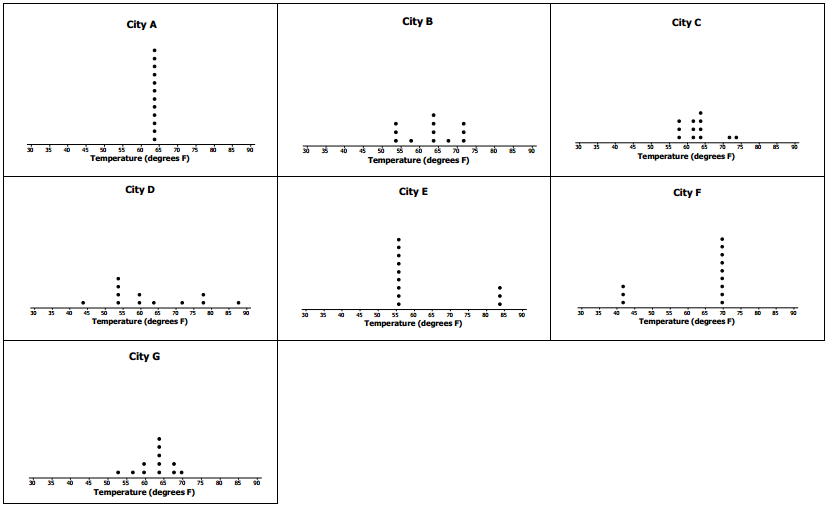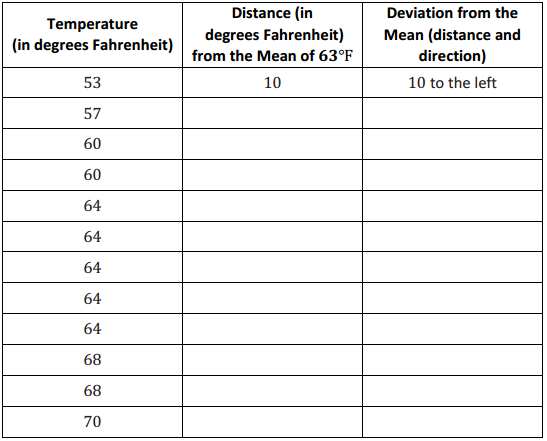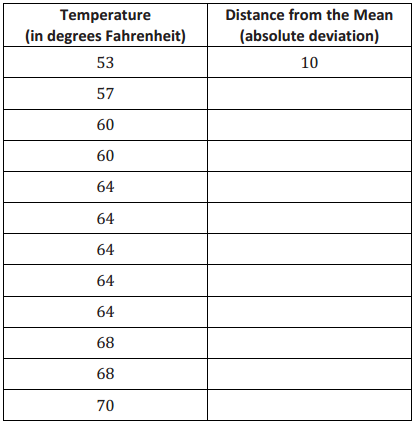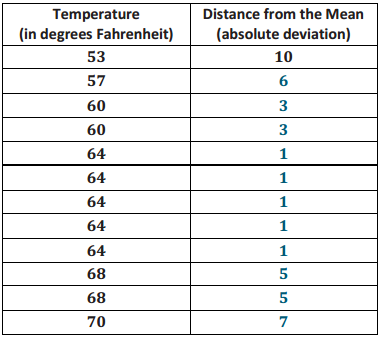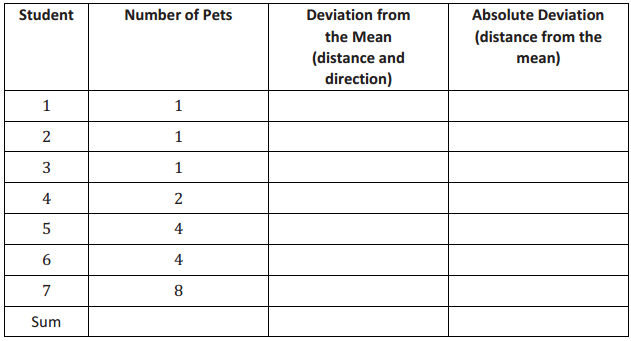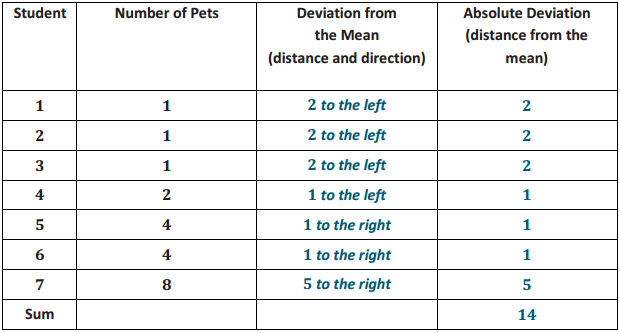Engage NY Eureka Math Grade 6 Module 6 Lesson 10 Answer Key
Eureka Math Grade 6 Module 6 Lesson 10 Example Answer Key
Example 1: Describing Distributions
In Lesson 9, Sabina developed the mean absolute deviation (MAD) as a number that measures variability in a data distribution. Using the mean and MAD along with a dot plot allows you to describe the center, spread, and shape of a data distribution. For example, suppose that data on the number of pets for ten students are shown in the dot plot below.

There are several ways to describe the data distribution. The mean number of pets for these students is 3, which is a measure of center. There is variability in the number of pets the students have, and data values differ from the mean by about 2.2 pets on average (the MAD). The shape of the distribution is heavy on the left, and then it this out to the right.
Exercises 1 – 4:
Exercise 1.
sSuppose that the weights of seven middle school students’ backpacks are given below.
a. Fill in the following table.

Answer:

b. Draw a dot plot for these data, and calculate the mean and MAD.
Answer:
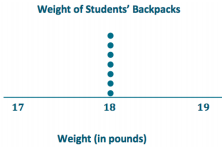
The mean is 18 pounds.
The MAD is 0 pounds.
c. Describe this distribution of weights of backpacks by discussing the center, spread, and shape.
Answer:
The mean is 18 pounds. There is no variability.
All of the data values are equal.
Exercise 2.
Suppose that the weight of Elisha’s backpack is 17 pounds rather than 18 pounds.
a. Draw a dot plot for the new distribution.
Answer:
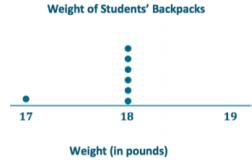
b. Without doing any calculations, how is the mean affected by the lighter weight? Would the new mean be the same, smaller, or larger?
Answer:
The mean will be smaller because the new weight is smaller than the other weights.
c. Without doing any calculations, how is the MAD affected by the lighter weight? Would the new MAD be the same, smaller, or larger?
Answer:
The MAD would be larger because now there is variability, so the MAD is greater than zero.
Exercise 3.
Suppose that in addition to Elisha’s backpack weight having changed from 18 to 17 pounds, Fred’s backpack weight is changed from 18 to 19 pounds.
a. Draw a dot plot for the new distribution.
Answer:
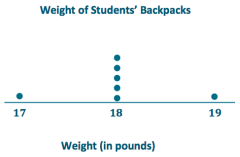
b. Without doing any calculations, how would the new mean compare to the original mean?
Answer:
The new mean is 18 1b., which was also the original mean.
c. Without doing any calculations, would the MAD for the new distribution be the same as, smaller than, or larger than the original MAD?
Answer:
Since there is more variability, the MAD is larger than the original MAD.
d. Without doing any calculations, how would the MAD for the new distribution compare to the one in Exercise 2?
Answer:
There is more variability, so the MAD is greater than the MAD in Exercise 2.
Exercise 4.
Suppose that seven-second graders’ backpack weights were as follows:

a. How is the distribution of backpack weights for the second graders similar to the original distribution for the middle school students given in Exercise 1?
Answer:
Both have no variability, so the MAD is 0 pounds in both cases. The shapes of the distributions on the dot plots are the same.
b. How are the distributions different?
Answer:
The means are different. One mean is 18 pounds, and the other is 5 pounds.
Example 2: Using the MAD
Using data to make decisions often involves comparing distributions. Recall that Robert is trying to decide whether to move to New York City or to San Francisco based on temperature. Comparing the center, spread, and shape for the two temperature distributions could help him decide.
Dot Plot of Temperature for New York City

Dot Plot of Temperature for San Francisco

From the dot plots, Robert saw that monthly temperatures in New York City were spread fairly evenly from around 40 degrees to around 85 degrees, but in San Francisco, the monthly temperatures did not vary as much. He was surprised that the mean temperature was about the same for both cities. The MAD of 14 degrees for New York City told him that, on average, a month’s temperature was 14 degrees away from the mean of 63 degrees.
That is a lot of variability, which is consistent with the dot plot. On the other hand, the MAD for San Francisco told him that San Francisco’s monthly temperatures differ, on average, only 3.5 degrees from the mean of 64 degrees. So, the mean doesn’t help Robert very much in making a decision, but the MAD and dot plot are helpful.
Which city should he choose if he loves warm weather and really dislikes cold weather?
Answer:
He should choose San Francisco because there is little variability, and it does not get as cold as New York City.
Exercises 5 – 7:
Exercise 5.
Robert wants to compare temperatures for Cities B and C.

a. Draw a dot plot of the monthly temperatures for each of the cities.
Answer:
City B

City C

b. Verify that the mean monthly temperature for each distribution is 63 degrees.
Answer:
The data are nearly symmetrical around 63 degrees for City B. The sum of the distances to the left of the mean is equal to the sum of the distances to the right of the mean. Each of these sums is equal to 32 degrees.
For City C, the sum of the distances to the left of the mean is equal to the sum of the distances to the right of the mean. Each sum is equal to 61.
c. Find the MAD for each of the cities. Interpret the two MADs in words, and compare their values. Round your answers to the nearest tenth of a degree.
Answer:
1. The MAD is 5.3 degrees for City B, which means that, on average, the monthly temperatures differ by 5.3 degrees from the mean of 63 degrees.
2. The MAD is 10.2 degrees for City C, which means that, on average, the monthly temperatures differ by 10.2 degrees from the mean of 63 degrees.
Exercise 6.
How would you describe the differences in the shapes of the monthly temperature distributions of the two cities?
Answer:
The temperatures are nearly symmetric around the mean in City B. The temperatures are compact to the left of the mean for City C and then spread out to the right (skewed right).
Exercise 7.
Suppose that Robert had to decide between Cities D, E, and F.

a. Draw a dot plot for each distribution.
Answer:
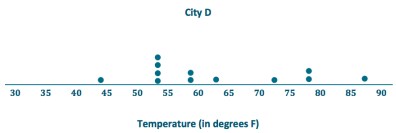
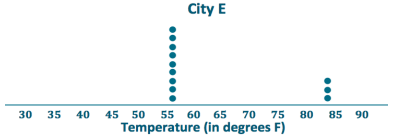

b. Interpret the MAD for the distributions. What does this mean about variability?
Answer:
The MADs are, all the same, so the monthly temperatures differ, on average, 10.5 degrees from the mean of 63 degrees. This means that all of the distributions have the same amount of variability.
c. How will Robert decide to which city he should move to? List possible reasons Robert might have for choosing each city.
Answer:
Robert needs to look more at the shapes of the distributions to help him make a decision.
City D – Appears to have four seasons with widespread temperatures.
City E – Has mainly cold weather and ¡s only hot for 3 months.
City F – Has mainly moderate weather and only a few cold months.
Eureka Math Grade 6 Module 6 Lesson 10 Problem Set Answer Key
Question 1.
Draw a dot plot of the times that five students studied for a test if the meantime they studied was 2 hours and the MAD was 0 hours.
Answer:
Since the MAD is 0 hours, all data values are all the same, and they would be equal to the mean value.

Question 2.
Suppose the times that five students studied for a test are as follows:

Michelle said that the MAD for this data set is 0 hours because the dot plot is balanced around 2. Without doing any calculations, do you agree with Michelle? Why or why not?
Answer:
No. Michelle is wrong. There is variability within the data set, so the MAD is greater than 0 hours.
Note:
If students agree with Michelle, then they have not yet mastered an understanding that the MAD is measuring variability. They need to understand that if data values differ in a distribution, whether the distribution is symmetric or not, then there is variability. Therefore, the MAD cannot be 0 hours.
Question 3.
Suppose that the number of text messages eight students receive on a typical day is as follows:

a. Draw a dot plot for the number of text messages received on a typical day for these eight students.
Answer:
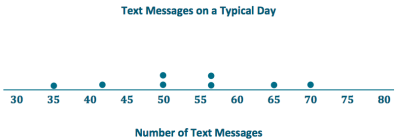
b. Find the mean number of text messages these eight students receive on a typical day.
Answer:
Since the distribution appears to be somewhat symmetrical around a value in the 50’s, students could guess a value for the mean, such as 52 or 53, and then check the sum of the distances on either side of their predictions. Using the formula, the mean is 53 text messages because \(\frac{424}{8}\) = 53.
c. Find the MAD for the number of text messages, and explain its meaning using the words of this problem.
Answer:
The sum of the absolute deviations is 70. So, \(\frac{70}{8}\) yields a MAD of 8. 75 text messages.
This means that, on average, the number of text messages these eight students receive on a typical day differs by 8.75 text messages from the group mean of 53 text messages.
d. Describe the shape of this data distribution.
Answer:
The shape of this distribution is fairly symmetrical (balanced) around the mean of 53 messages.
e. Suppose that in the original data set, Student 3 receives an additional five text messages per day and Student 4 receives five fewer text messages per day.
i. Without doing any calculations, does the mean for the new data set stay the same, increase, or decrease as compared to the original mean? Explain your reasoning.
Answer:
The mean would remain at 53 messages because one data value moved the same number of units to the right as another data value moved to the left. So, the balance point of the distribution does not change.
ii. Without doing any calculations, does the MAD for the new data set stay the same, increase, or decrease as compared to the original MAD? Explain your reasoning.
Answer:
Since the lowest data point moved closer to the mean and the highest dota point moved closer to the mean, the resulting distribution would be more compact than the original distribution. Therefore, the MAD would decrease.
Eureka Math Grade 6 Module 6 Lesson 10 Exit Ticket Answer Key
Question 1.
A dot plot of times that five students studied for a test is displayed below.

a. Calculate the mean number of hours that these five students studied. Then, use the mean to calculate the absolute deviations, and complete the table.
Answer:
The mean is 2 hours since the sums of the distances on either side of 2 hours are equal.

b. Find and interpret the MAD for this data set.
Answer:
\(\frac{5}{5}\) = 1
The MAD is 1 hour. This means that, on average, the study times differed by 1 hour from the group mean of 2 hours.
Question 2.
The same five students are preparing to take a second test. Suppose that the numbers of study hours were the same except that Ben studied 2.5 hours for the second test (1. 5 hours more), and Emma studied only 3 hours for the second test (1. 5 hours less).
a. Without doing any calculations, is the mean for the second test the same as, greater than, or less than the mean for the first test? Explain your reasoning.
Answer:
The mean would be the same since the distance that one data value moved to the right was matched by the distance another data value moved to the left. The distribution is still balanced at the same place.
b. Without doing any calculations, is the MAD for the second test the same as, greater than, or less than the MAD for the first test? Explain your reasoning.
Answer:
The MAD would be smaller since the data values are clustered closer to the mean.
